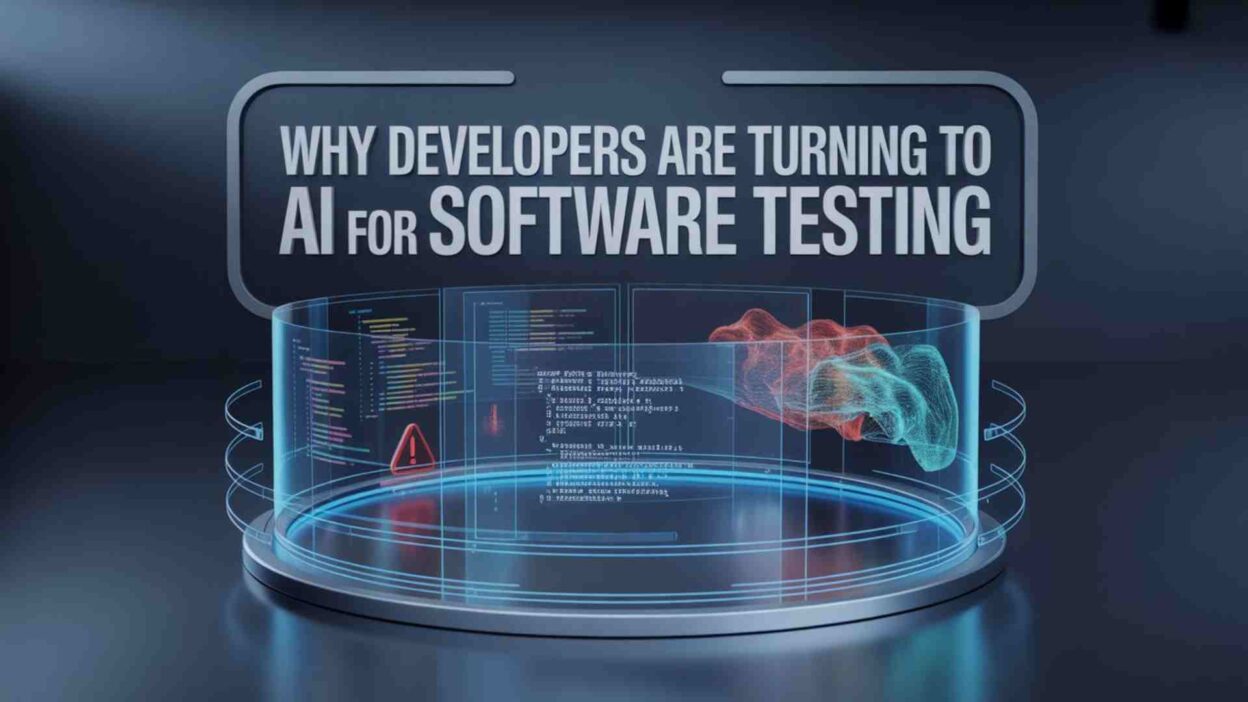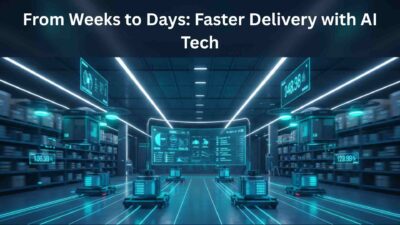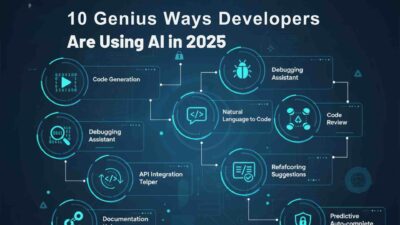Introduction
TL;DR Software testing has changed forever. Developers face mounting pressure to deliver flawless applications quickly. Traditional testing methods consume too much time. Manual testing drains resources and misses critical bugs.
Table of Contents
The use of AI in software testing and debugging offers a breakthrough solution. Artificial intelligence transforms how teams approach quality assurance. Developers worldwide are adopting these intelligent systems.
Testing automation reaches new heights with AI capabilities. Machine learning algorithms detect patterns humans might overlook. The software development landscape shifts toward smarter testing practices.
Companies save millions by implementing AI-driven testing frameworks. Bug detection happens faster than ever before. Development cycles shrink while software quality improves dramatically.
This blog explores why developers embrace AI testing solutions. We examine real benefits and practical applications. You’ll discover how AI reshapes software quality assurance.
Understanding AI in Software Testing
What Makes AI Testing Different
Traditional testing follows rigid scripts and predefined paths. AI testing adapts and learns from each test execution. The technology mimics human reasoning but operates at machine speed.
Neural networks power modern testing frameworks. These systems recognize anomalies without explicit programming. Pattern recognition happens automatically across millions of data points.
AI algorithms evolve with your application. They learn normal behavior and flag unusual patterns. Testing becomes proactive rather than reactive.
Machine learning models predict where bugs likely hide. They prioritize test cases based on risk assessment. Resources focus on critical application areas.
Core Technologies Behind AI Testing
Deep learning drives visual testing capabilities. Computer vision identifies UI inconsistencies across different devices. Image recognition spots pixel-perfect differences instantly.
Natural language processing enables test case generation from requirements. AI reads documentation and creates comprehensive test scenarios. The use of AI in software testing and debugging eliminates manual test writing.
Reinforcement learning optimizes test execution strategies. Systems learn which tests provide maximum coverage. Testing efficiency improves with each iteration.
Predictive analytics forecast potential failure points. Historical data reveals patterns leading to bugs. Developers address issues before they occur.
Types of AI-Powered Testing Tools
Autonomous testing platforms execute tests without human intervention. They navigate applications like real users would. Self-healing capabilities adjust to UI changes automatically.
Intelligent test generation tools create scenarios from user stories. They understand context and business logic. Test coverage expands without additional manual effort.
Visual regression testing uses AI for pixel comparison. These tools detect unintended visual changes instantly. Design consistency remains intact across updates.
Performance testing AI predicts system behavior under load. Machine learning models simulate realistic user patterns. Bottlenecks surface before production deployment.
Why Developers Choose AI for Testing
Speed and Efficiency Gains
Manual testing takes weeks or months for complex applications. AI completes the same work in hours. Development velocity increases dramatically with automated intelligence.
Test execution runs continuously without breaks. AI systems operate around the clock. Teams receive instant feedback on code quality.
Parallel testing across multiple environments happens simultaneously. The use of AI in software testing and debugging accelerates release cycles. Time-to-market shrinks significantly.
Regression testing becomes painless with AI automation. Every code change triggers comprehensive validation. Developers deploy with confidence.
Enhanced Bug Detection Capabilities
AI discovers bugs humans consistently miss. Complex interaction patterns reveal hidden defects. Machine learning identifies edge cases automatically.
Anomaly detection algorithms spot unusual system behavior. They compare current performance against baseline metrics. Deviations trigger immediate alerts.
Deep testing reaches areas that manual testers rarely explore. AI navigates through countless execution paths. Code coverage reaches unprecedented levels.
False positive rates drop with intelligent filtering. AI distinguishes real issues from noise. Development teams focus on genuine problems.
Cost Reduction and Resource Optimization
Hiring manual testers becomes less necessary. AI handles repetitive testing tasks efficiently. Companies redirect human talent to strategic work.
Infrastructure costs decrease with optimized test execution. AI prioritizes tests that matter most. Unnecessary test runs are eliminated.
Bug fixes cost less when caught early. AI detects issues during development phases. Production incidents decline dramatically.
Maintenance overhead shrinks with self-healing tests. Scripts adapt to application changes automatically. Test suite upkeep requires minimal effort.
Improved Test Coverage
AI explores application paths exhaustively. Every feature combination gets validated. Coverage gaps disappear with intelligent exploration.
Risk-based testing focuses on critical functionality. AI assesses which areas need thorough validation. Testing depth adjusts based on complexity.
Cross-platform testing happens seamlessly. AI validates behavior across browsers and devices. Compatibility issues surface immediately.
API testing reaches comprehensive levels. AI generates diverse input combinations. Backend services face rigorous validation.
AI Applications in Software Debugging
Intelligent Error Detection
Static code analysis powered by AI finds vulnerabilities early. Machine learning models recognize problematic code patterns. Security flaws get flagged before commit.
Runtime error prediction identifies potential crashes. AI analyzes execution flows and resource usage. Problems surface during development rather than production.
Memory leak detection becomes automatic. AI monitors resource allocation patterns continuously. Performance degradation gets prevented proactively.
The use of AI in software testing and debugging includes smart logging. Systems highlight relevant log entries automatically. Debugging time drops significantly.
Automated Root Cause Analysis
AI traces errors back to their origin instantly. Complex failure chains get untangled automatically. Developers receive precise problem locations.
Stack trace analysis happens intelligently. Machine learning identifies the actual culprit code. Red herrings get filtered out effectively.
Historical bug data informs current investigations. AI recognizes similar issues from past incidents. Solutions appear faster with pattern matching.
Dependency analysis reveals cascading failures. AI maps how components interact and fail together. System-wide issues become clear quickly.
Predictive Debugging
Machine learning predicts where bugs will likely occur. Code complexity metrics guide prevention efforts. High-risk areas receive extra attention.
Change impact analysis happens automatically. AI forecasts which modifications might introduce defects. Testing focuses on affected components.
Performance degradation gets predicted before users notice. Resource consumption patterns reveal future problems. Capacity planning becomes data-driven.
Security vulnerability prediction identifies weak points. AI scans for patterns matching known exploits. Patches happen before attacks occur.
Self-Healing Systems
AI-powered applications fix certain bugs automatically. Simple errors get corrected without human intervention. System uptime improves dramatically.
Configuration issues resolve themselves intelligently. AI adjusts settings based on optimal parameters. Manual tuning becomes unnecessary.
Failover mechanisms activate predictively. Systems reroute before complete failures happen. User experience remains smooth during issues.
The use of AI in software testing and debugging enables autonomous recovery. Applications bounce back from errors faster. Support tickets decline significantly.
Key Benefits for Development Teams
Faster Release Cycles
Continuous testing happens throughout development. Code moves to production more quickly. Market demands get met with agility.
Hotfix validation occurs in minutes. Emergency patches deploy with confidence. Downtime windows shrink dramatically.
Feature releases happen more frequently. Testing no longer bottlenecks deployment. Innovation accelerates across organizations.
Sprint velocities increase consistently. Teams complete more work in less time. Project timelines become more predictable.
Better Software Quality
Defect rates drop to record lows. AI catches bugs before human testers see them. Customer satisfaction rises accordingly.
Performance optimization happens continuously. AI identifies inefficiencies in real-time. Applications run smoother and faster.
Security posture strengthens with AI monitoring. Vulnerabilities get detected immediately. Data breaches become less likely.
User experience improves through comprehensive testing. Every interaction path gets validated thoroughly. Friction points disappear from workflows.
Team Productivity Enhancement
Developers spend less time on repetitive testing. Creative problem-solving gets more focus. Job satisfaction improves across teams.
Junior developers contribute more effectively. AI guidance helps them write better tests. Knowledge gaps close faster.
Code reviews become more efficient. AI highlights areas needing human attention. Review cycles complete quickly.
The use of AI in software testing and debugging frees up senior talent. Expert developers tackle complex architectural challenges. Innovation flourishes within organizations.
Competitive Advantage
Companies deploying AI testing ship faster. They beat competitors to market consistently. Market share grows with superior quality.
Customer trust builds through reliability. Fewer bugs mean happier users. Brand reputation strengthens over time.
Talent acquisition becomes easier. Top developers want to work with cutting-edge tools. Recruitment costs decrease.
Investment in AI testing pays dividends quickly. Return on investment appears within months. Business leaders notice the impact.
Real-World Implementation Strategies
Starting with AI Testing
Pilot projects test AI capabilities safely. Small applications provide learning opportunities. Teams build confidence gradually.
Tool selection requires careful evaluation. Different solutions fit different needs. Research helps identify the right platform.
Training teams on AI testing takes time. Developers need hands-on experience. Workshops accelerate the learning curve.
Integration with existing workflows happens incrementally. CI/CD pipelines incorporate AI tools step by step. Disruption stays minimal during transition.
Choosing the Right AI Testing Tools
Open-source options provide cost-effective entry points. Commercial solutions offer enterprise support. Budget considerations guide initial decisions.
Feature requirements drive tool selection. Visual testing needs differ from API testing. Matching capabilities to needs ensures success.
Scalability matters for growing applications. Tools must handle increasing complexity. Future-proofing investments saves money later.
The use of AI in software testing and debugging requires vendor reliability. Support quality impacts implementation success. References and reviews inform choices.
Integrating AI into Existing Workflows
Version control systems connect with AI testing platforms. Commits trigger automated test execution. Feedback loops close rapidly.
Issue tracking integrates with bug detection. AI creates tickets automatically. Workflow remains familiar to teams.
Documentation generation happens through AI analysis. Test results produce comprehensive reports. Stakeholders stay informed effortlessly.
Communication tools receive AI notifications. Teams know about failures immediately. Response times improve significantly.
Measuring AI Testing Success
Test coverage metrics show improvement clearly. Dashboards visualize quality trends. Progress becomes transparent to everyone.
Defect escape rates indicate effectiveness. Fewer production bugs prove value. ROI calculations become straightforward.
Cycle time measurements demonstrate speed gains. Release frequency increases measurably. Business impact becomes obvious.
Team satisfaction surveys reveal productivity changes. Developer happiness correlates with success. Cultural transformation becomes visible.
Common Challenges and Solutions
Initial Implementation Hurdles
Learning curves feel steep initially. Patience and training overcome difficulties. Competency builds with practice.
Legacy system integration poses technical challenges. Adapter layers bridge old and new technologies. Gradual migration reduces risk.
Data quality affects AI effectiveness. Clean test data improves results. Investment in data preparation pays off.
The use of AI in software testing and debugging requires mindset shifts. Teams must embrace automation fully. Change management strategies help adoption.
Overcoming Resistance to Change
Developers fear job displacement unnecessarily. AI augments rather than replaces human testers. Education addresses these concerns.
Skepticism about AI accuracy exists initially. Proof of concept demonstrations build trust. Results speak louder than promises.
Workflow disruption worries some team members. Gradual rollouts minimize impact. Success stories convert skeptics.
Management buy-in requires clear ROI projections. Business cases must show tangible benefits. Executive sponsorship ensures resources.
Managing False Positives
Initial AI configurations generate noise. Tuning parameters reduces false alarms. Learning periods require patience.
Test case refinement happens iteratively. AI models improve with feedback. Accuracy increases over time.
Human oversight remains important initially. Experts validate AI findings during setup. Confidence grows with experience.
Tool selection impacts false positive rates. Better algorithms produce cleaner results. Research prevents frustration.
Maintaining AI Testing Systems
Model retraining keeps AI effective. Applications evolve constantly. Regular updates maintain accuracy.
Test data requires ongoing curation. New scenarios expand coverage. Databases grow with application complexity.
The use of AI in software testing and debugging demands monitoring. System performance needs regular checks. Proactive maintenance prevents issues.
Tool updates bring new capabilities. Staying current maximizes value. Upgrade cycles become routine.
Future Trends in AI Testing
Advanced Machine Learning Applications
Generative AI creates realistic test data automatically. Synthetic users behave like real customers. Testing environments become more authentic.
Explainable AI makes decisions transparent. Developers understand why tests fail. Trust in automation deepens.
Federated learning enables privacy-preserving testing. Multiple organizations share insights without exposing data. Industry-wide quality improves.
Quantum computing may revolutionize testing speeds. Complex scenarios run in seconds. Performance testing reaches new frontiers.
Autonomous Testing Evolution
Self-evolving test suites adapt without human input. AI writes and maintains tests independently. Human oversight becomes minimal.
Intelligent test orchestration optimizes resource usage. Tests run when and where they provide the most value. Efficiency maximizes automatically.
Predictive test generation anticipates future requirements. AI understands product roadmaps. Test preparation happens proactively.
The use of AI in software testing and debugging will become fully autonomous. Systems handle entire quality assurance processes. Human roles shift toward strategy.
Integration with DevOps
AIOps platforms unify testing and operations. Development and deployment merge seamlessly. Quality assurance happens everywhere.
Infrastructure as code gets tested with AI. Configuration errors surface before deployment. System reliability improves dramatically.
Chaos engineering powered by AI finds weaknesses. Controlled failures test system resilience. Production stability increases.
Continuous verification happens post-deployment. AI monitors production constantly. Issues get resolved instantly.
Industry-Specific Applications
Healthcare software testing ensures patient safety. AI validates compliance automatically. Medical applications become more reliable.
Financial systems require rigorous validation. AI testing prevents costly errors. Regulatory compliance becomes easier.
Automotive software demands extreme reliability. AI testing saves lives through thoroughness. Vehicle systems operate flawlessly.
E-commerce platforms benefit from performance testing. AI simulates Black Friday traffic levels. Revenue losses from crashes disappear.
Best Practices for AI Testing Success
Building a Strong Foundation
Start with clear objectives and measurable goals. Success criteria guide implementation decisions. Progress tracking becomes straightforward.
Invest in team training adequately. Knowledge gaps hinder adoption significantly. Education budgets pay dividends quickly.
Choose tools matching organizational maturity. Overly complex solutions overwhelm teams. Right-sized technology ensures success.
The use of AI in software testing and debugging requires infrastructure investment. Computing resources support AI operations. Adequate capacity prevents bottlenecks.
Creating Effective Test Strategies
Balance AI automation with manual testing. Human insight remains valuable. Hybrid approaches work best.
Prioritize test cases intelligently. Not everything needs AI validation. Focus resources on high-impact areas.
Design tests for maintainability. Even AI tests need occasional updates. Clean architecture reduces technical debt.
Document AI testing processes thoroughly. Knowledge transfer becomes critical. Teams operate effectively during transitions.
Continuous Improvement Mindset
Review AI testing metrics regularly. Performance trends reveal optimization opportunities. Refinement never stops.
Gather feedback from development teams. User experience drives tool selection. Adoption depends on usability.
Experiment with new AI capabilities. Technology evolves rapidly. Early adoption creates advantages.
Share learnings across organizations. Communities benefit from collective knowledge. Industry advancement accelerates together.
Security and Compliance Considerations
Protect test data rigorously. Privacy regulations apply to testing environments. Compliance violations carry penalties.
Audit AI testing decisions regularly. Bias detection prevents unfair outcomes. Ethical AI usage matters.
Secure the AI testing infrastructure properly. These systems access sensitive code. Breaches have serious consequences.
The use of AI in software testing and debugging must follow standards. Industry regulations guide implementation. Certification demonstrates commitment.
FAQs About AI in Software Testing
How does AI improve software testing accuracy?
AI analyzes vast amounts of data instantly. Pattern recognition surpasses human capabilities. Algorithms detect subtle anomalies consistently.
Machine learning models learn from historical bugs. They predict where new defects might hide. Testing focuses on high-risk areas.
Computer vision validates UI elements precisely. Pixel-perfect comparison happens automatically. Visual regressions never slip through.
Can AI completely replace manual testers?
AI handles repetitive tasks brilliantly. Creative test design still needs human input. Exploratory testing benefits from human intuition.
Complex user experience evaluation requires empathy. AI lacks human emotional understanding. Critical thinking remains irreplaceable.
The use of AI in software testing and debugging augments human capability. Teams become more efficient together. Collaboration produces best results.
What skills do developers need for AI testing?
Basic machine learning understanding helps significantly. Deep expertise is not required. Familiarity with concepts aids adoption.
Programming skills apply directly to AI testing. Scripting and automation knowledge transfers easily. Learning curves remain manageable.
Analytical thinking becomes more important. Interpreting AI results requires judgment. Critical evaluation skills matter greatly.
How much does AI testing cost?
Open-source tools provide free starting points. Commercial platforms charge based on usage. Costs scale with organization size.
Infrastructure expenses vary by implementation. Cloud services offer flexible pricing. On-premise solutions require upfront investment.
ROI typically appears within six months. Savings from faster releases accumulate quickly. Long-term value far exceeds costs.
Which programming languages work with AI testing?
Python dominates AI testing frameworks. Extensive libraries support machine learning. Most tools offer Python integration.
JavaScript works for web application testing. Node.js enables AI testing automation. Browser automation integrates seamlessly.
Java and C# support enterprise AI testing. Established frameworks adopt AI capabilities. Language choice rarely limits options.
How long does AI testing implementation take?
Pilot projects completed in weeks. Small applications provide quick wins. Learning happens rapidly.
Full enterprise rollouts span several months. Cultural change takes time. Patience ensures successful adoption.
The use of AI in software testing and debugging shows benefits immediately. Early results build momentum. Complete transformation takes commitment.
Does AI testing work for mobile applications?
Mobile testing benefits tremendously from AI. Device fragmentation challenges disappear. AI validates across thousands of configurations.
Gesture recognition happens automatically. Touch interactions get tested thoroughly. User experience validation improves.
App performance testing uses AI effectively. Battery consumption and memory usage get optimized. Mobile quality reaches new standards.
What industries benefit most from AI testing?
Technology companies lead AI testing adoption. Software-focused organizations see immediate value. Digital products demand rigorous testing.
Financial services require extreme reliability. AI testing ensures transaction accuracy. Regulatory compliance becomes manageable.
Healthcare applications need thorough validation. Patient safety depends on software quality. AI testing provides necessary assurance.
Can AI testing handle legacy systems?
Legacy application testing poses unique challenges. API layers enable AI integration. Modern testing wraps older systems.
Gradual modernization works effectively. Critical paths get AI testing first. Complete rewrites are not necessary.
The use of AI in software testing and debugging adapts to constraints. Solutions exist for various architectures. Legacy systems benefit too.
How does AI testing impact team dynamics?
Collaboration increases with AI testing. Teams focus on strategic work. Tedious tasks disappear from workflows.
Job satisfaction improves measurably. Developers enjoy more creative challenges. Morale rises across organizations.
Skill development accelerates naturally. Team members learn cutting-edge technologies. Career growth opportunities expand.
Read More: How Hospitals Use AI Patient Follow-Up Automation Tools
Conclusion

The software development world transforms rapidly. AI testing represents the future of quality assurance. Developers who adopt these technologies gain significant advantages.
Traditional testing methods cannot keep pace with modern demands. Applications grow more complex daily. Manual approaches simply do not scale.
The use of AI in software testing and debugging delivers measurable results. Faster releases combine with better quality. Companies achieve both speed and reliability.
Teams report higher satisfaction with AI testing tools. Tedious work disappears from daily routines. Creative problem-solving takes center stage.
Cost savings justify investments quickly. Fewer production bugs reduce support costs. Time-to-market improvements capture market opportunities.
Future developments promise even greater capabilities. AI testing will become more autonomous. Human roles will evolve toward strategic guidance.
Organizations hesitating risk falling behind competitors. Early adopters establish quality advantages. Market leadership follows technological adoption.
Software quality expectations continue rising. Users demand flawless experiences consistently. AI testing makes meeting these expectations possible.
Development teams deserve better tools. AI testing reduces frustration and increases productivity. Job satisfaction improves across the board.






[…] Read more:-Why Developers Are Turning to AI for Software Testing […]